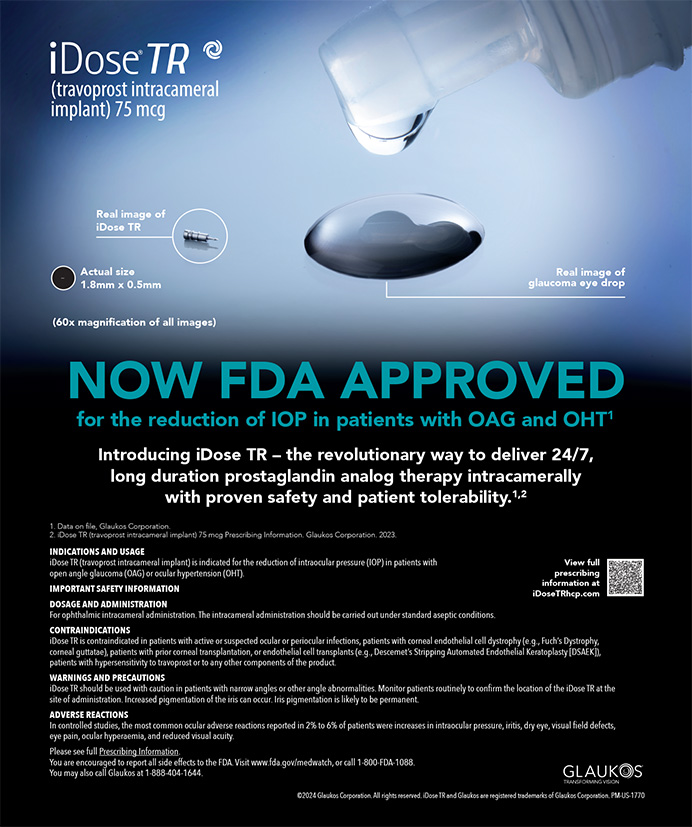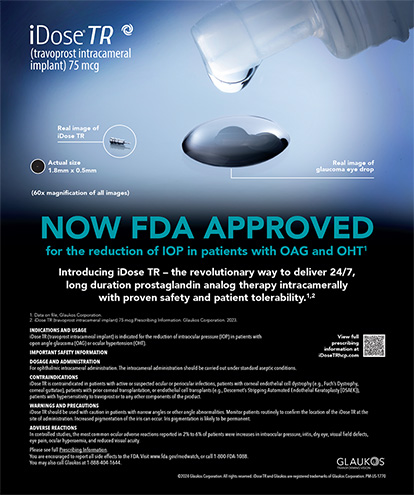Two categories of patients with dry eye disease (DED) are particularly challenging to manage. The groups include patients who are extremely symptomatic but do not have many clinical signs, and the reverse, those with significant clinical signs but mild symptoms.
SYMPTOMATIC WITH FEW CLINICAL SIGNS
No Demographic Identifier
It is difficult to predict, based on demographics,
patients who experience significant DED symptoms
but few clinical signs. This individual is typically not the
classic older patient such as a postmenopausal woman
taking numerous medications. Often, younger patients
and those postsurgery will present in this manner with
significant symptoms but little in the way of conjunctival
or corneal staining.
Evaporative Disease
Many times, symptomatic patients with few clinical
signs will have a significant evaporative component to
their DED. Eventually, because of the disease's chronicity,
patients with an evaporative condition will develop
a measure of aqueous-deficient DED. Evaporative disease
does not only indicate that lid margin disease is
present. Conjunctival chalasis is a common cause of
evaporative DED, as it causes the tear film to mechanically
break up. Ophthalmologists should evaluate the
junction between the conjunctiva and the lid margins
in DED patients, as it is important to assess for conjunctival
chalasis. It is crucial to recognize that even mild
conjunctival chalasis can cause various symptoms of
DED in any age group, particularly in younger patients.
Foreign body sensation, inconsistent vision, photophobia,
or burning sensation can occur from the chalasis
itself or from the scattered tear film as a result of the
redundant conjunctiva. Commonly, the patient's tear
film will appear elevated centrally, but his or her nasal
and temporal film will be broken up (Figure).
Staining and Dyes
DED cannot be easily identified by classic signs
observed during a brief baseline examination using fluorescein
staining. If the ophthalmologist is not looking
for devitalized cells with lissamine green (my preference)
or rose bengal, it may go undetected. These patients
will have little to no corneal staining but very significant conjunctival staining. Other types of patients who may
not stain classically with fluorescein include those with
superior limbal keratoconjunctivitis, so it is imperative to
use other dyes. Often, I will wet and apply both the fluorescein
and lissamine strips simultaneously so that the
examination does not take any longer.
Everting the Lids
Flipping patients' lids can be very telling. Although
these DED patients may not always have obvious corneal
staining, they may have irregular elevations and scarring
in the tarsal plates from prior insults, such as a remote
history of viral conjunctivitis. Subtarsal scarring can lead
to increased irritation, even if the patient does not present
with obvious signs of epitheliopathy on the cornea.
Tear Film Height
It is crucial that clinicians assess the quality and quantity
of the tear film's height. The meniscus may be broken
up by conjunctival chalasis. The eye should have a
healthy tear film of about 1 mm that is smooth across
the lower lid margin. If it is lower than this, or has poor
quality (ie, foamy or has floating debris), the patient can
commonly be symptomatic.
TREATMENT
Even if a patient does not have an obvious aqueousdeficient component to DED, he or she needs as much of a smooth tear film as possible. If the patient has evaporative disease, then the treatment has to address the source of evaporation, including addressing the lid margin disease as well as surgically taking care of the chalasis to provide a more functional and adequate tear film.
When receiving tertiary level care, the treatment regimens are similar whether the patient has evaporative disease first or aqueous. For example, all of my patients benefit from proper lid hygiene with scrubs and compresses, steps to ensure a healthy meibum, and treatment with cyclosporine ophthalmic emulsion 0.05% (Restasis; Allergan, Inc.). The latter anti-inflammatory agent works to prevent lid disease as well as treat the inflammatory cytokines that are causing DED.1
Regarding lid hygiene for anterior and/or posterior blepharitis, patients often require more than the daily warm compress and lid cleanser/scrub routine. If they are suspicious for Demodex, they require a tea tree oil shampoo or scrub for at least a month. For MGD, some patients respond very well to topical azithromycin (AzaSite; Merck). Some patients unfortunately have little to no response to low-dose doxycycline. For such more recalcitrant posterior blepharitis, I have had success using oral azithromycin 500 mg daily, 3 days in a row, for 3 to 5 weeks and then using low-dose doxycycline and omega-3 fatty acids for maintenance.2 This treatment is also effective for combating flare-ups of rosacea. Lastly, in-office meibomian gland expression techniques and devices may be useful.
CLINICAL SIGNS AND MILD SYMPTOMS
Patients who present with many clinical signs and yet very few symptoms are typically older. These individuals, who will exhibit extensive staining, will often complain of suboptimal vision but have no foreign body sensation or pain. It is imperative that these patients understand that the cause of their visual complaints is DED even if they are not sensing it. Older patients with this type of disease do not feel discomfort often due to various reasons, including age, medications that may be masking their symptoms as well as contributing to their DED, and a chronic hyperosmolar tear film with concentrated inflammatory cytokines leads to diminished corneal sensation and thus, a neuropathic component.
I often treat this category of patients with aggressive preservative-free lubrication, cyclosporine, possibly punctal occlusion and go from there. These patients also need to optimize their environment, by eliminating air movement sources such as ceiling fan use. In counseling these patients, I explain that their condition is multifactorial, oftentimes a combination of aging, a side effect of their medications, chronic medical conditions, and their environment. I provide them with literature, and I outline that their treatment is not a one-time event. As with their other chronic conditions, DED requires long-term therapy.
CONCLUSION
Patients with DED who present with moderate symptoms yet few clinical signs, and those who present with few symptoms yet many clinical signs, can be among the most challenging to manage. A comprehensive clinical examination that includes a thorough history as well as the temporal nature of the patients' symptoms, evaluating for causes of tear break up, use of a few key tests such as lissamine green staining, everting the eyelids, and determining the height of the tear film, can go a long way toward ensuring optimal outcomes.
Elizabeth Yeu, MD, is an assistant professor of ophthalmology for the Cullen Eye Institute at Baylor College of Medicine in Houston. She is a consultant to and speaker for Allergan, Inc. Dr. Yeu may be reached at (713) 798-5143; yeu@bcm.edu.
- Pflugfelder SC. Antiinflammatory therapy for dry eye. Am J Ophthalmol. 2004;137(2):337-342.
- Igami TZ, Holzchuh R, Osaki TH, et al. Oral azithromycin for treatment of posterior blepharitis. Cornea. 2011;30(10):1145-1149.


